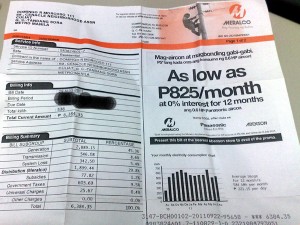MANILA, Philippines—Customers of Manila Electric Co., the country’s biggest power distributor, can expect their electricity bills to go down by 12 centavos per kilowatt-hour (kWh) this May due mainly to lower transmission charges.
This means that households consuming 100 kWh a month can expect a reduction of P5.65 in their May power bills, while those consuming 200 kWh will see a decrease of P23.70, according to Lawrence S. Fernandez, assistant vice president and head of utility economics for Meralco.
Households that have been consuming 300 kWh and 400 kWh monthly would enjoy reductions of P35.55 and P47.40, respectively, Fernandez said in a phone interview on Thursday.
In a separate statement, Meralco explained that the transmission charge registered the biggest decrease at around 12 centavos per kWh, mainly due to lower ancillary service charges from the National Grid Corp. of the Philippines (NGCP).
Other bill components that registered reductions include the system loss charge, lifeline rate subsidy, the value added tax (VAT) and the local franchise tax, which had a cumulative reduction of 8 centavos per kWh.
However, the generation charge or the cost of power sourced by Meralco from its suppliers, registered an increase of 8 centavos per kWh to P5.47 per kWh during the April supply month. The cost of power consumed in a given month, say April, is billed to end-consumers the following month, or in the case, in May.
This month’s generation charge, however, remains to be lower by 13 centavos compared to the generation charge in May 2012.
Meralco explained that with the onset of summer, demand for power climbed to record levels during the April supply month.
“Peak demand in Luzon hit 8,221 megawatts (MW), overtaking the 7,898 MW recorded in 2012. Similarly, peak demand in the Meralco service area set a new record of 5,829 MW in April, versus 2012’s 5,633 MW,” the distribution utility explained.
“As a result, Meralco had to obtain more supply from the Wholesale Electricity Spot Market to supplement its sourcing from the Power Supply Agreements (PSAs), Independent Power Producers (IPPs), and the National Power Corp. (Napocor),” it further reported.
The power firm noted that while the cost of power obtained from the PSAs rose to P4.34 per kWh in April from the previous month’s P4.24 per kWh, this power rate was still the lowest compared to Meralco’s other suppliers.
Meanwhile, the cost of power purchased from the IPPs fell by 17 centavos per kWh to P4.90 per kWh, while Napocor’s effective rate similarly went down by 23 centavos to P9.65 per kWh.
Napocor’s power rate included the P714 million per month being collected from end-consumers for the recovery of fuel and foreign exchange costs incurred by its Small Power Utilities Group (SPUG).
Power purchases from the WESM registered a rate of P17.15 per kWh, inclusive of adjustments and line rental charges for bilateral contract quantities.
During the April supply month, Meralco sourced 51 percent of its electricity requirements from the PSAs; 37 percent from the IPPs; while the remaining 12 percent was sourced from Napocor, WESM and other small generators.
The power firm says it does not earn from generation charges. Payments for the generation charge, which is a pass-through cost for Meralco, goes to its power suppliers. The rest of the pass-through costs included transmission, taxes, universal charges, and other charges.
Meralco’s own rates—in the form of distribution, supply and metering charges—account for only about 18 percent of the total electricity bill.
